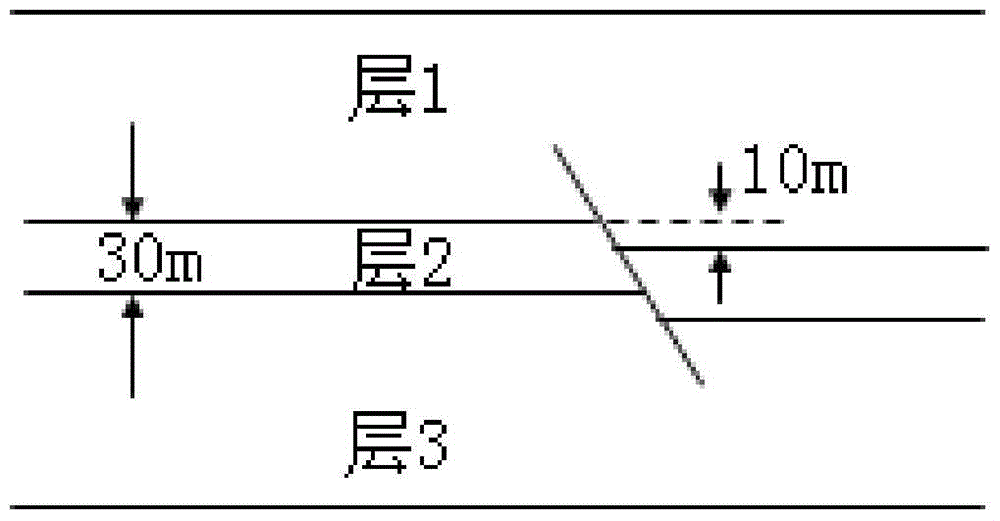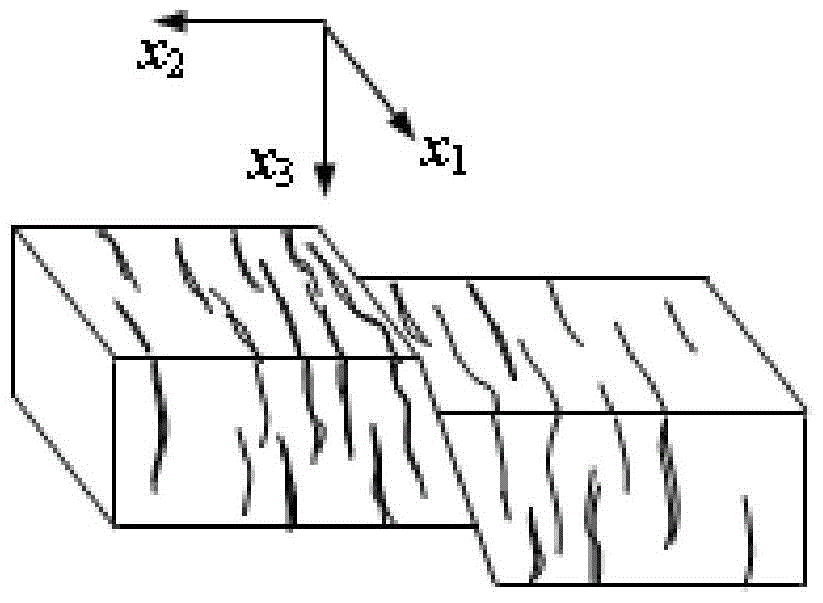A method and system for inversion of fracture density in seismic strata
A technology of fracture density and fracture, which is applied in the field of seismic formation fracture fracture density inversion method and system, can solve the problems that cannot meet the quantitative evaluation of formation permeability and the calculation requirements of oil and gas reserves in fractured reservoirs
- Summary
- Abstract
- Description
- Claims
- Application Information
AI Technical Summary
Problems solved by technology
Method used
Image
Examples
Embodiment 1
[0060] This example is a three-layer geological model containing faults, the model size is 1000m×800m; the grid size is: DX=DZ=10m, the fault drop is 10m, the upper and lower layers are the same, the middle layer has cracks, and the thickness of the crack layer is 30m, and the fracture direction is the same as x 1 The axes are parallel, and the model parameters are shown in Table 1:
[0061]
[0062]
[0063] Table 1
[0064] The corresponding schematic diagram of the model is as Figure 1a , Figure 1b as well as Figure 1c shown. The depth direction of fractured density rock changes as figure 2 As shown by the solid line, fissures develop near the fault, and the density of fissures gradually decreases toward both sides, as shown in image 3 shown by the solid line.
[0065] like Figure 4 As shown, it is a flow chart of a method for inversion of seismic formation fracture density in this embodiment, which includes the following steps:
[0066] Step 401, collec...
Embodiment 2
[0160] It is a five-layer geological model, and the model size and grid size are the same as those in Embodiment 1. There are cracks in the third and fourth layers, the crack density of the third layer is 0.12, and the crack direction is the same as x 1 The angle between the axes is -35°, the crack density of the fourth layer is 0.06, and the crack direction is the same as x 1 Axis angle is -75 °, the model of embodiment 2 is as Figure 7 The corresponding parameters are shown in Table 2.
[0161] layer number
Thickness (m)
p(g / cm 2 )
Vp(m / s)
Vs(m / s)
e
θ (degrees)
1
400
2400
3640
1750
0
0
2
70
2300
3157
1579
0
0
3
50
2450
3513
1887
0.12
-35
4
80
2500
3726
2053
0.06
-75
5
600
2400
3640
1750
0
0
[0162] Table 2
[0163] The model collects 30 shots of three-component seismic data, Fi...
Embodiment 3
[0169] Such as Figure 10 As shown, it is a structural diagram of a seismic formation fracture crack density inversion system of the present invention, including the following units:
[0170] A preprocessing unit 1001, configured to acquire three-component seismic data, and perform preprocessing on the three-component seismic data to obtain measured three-component shot data;
[0171] The preprocessing of the three-component seismic data includes: two-horizontal component rotation, three-component static correction, surface consistent amplitude compensation and pre-stack noise removal.
[0172] Depth-domain compressional-wave velocity and formation mass density calculation unit 1002, used to extract common center point gather data from the vertical component shot-set data in the three-component shot-set data, and perform compressional-wave velocity analysis, time-domain compressional-wave velocity calculation and compressional-wave velocity analysis. Time-depth conversion, ob...
PUM
 Login to View More
Login to View More Abstract
Description
Claims
Application Information
 Login to View More
Login to View More - R&D
- Intellectual Property
- Life Sciences
- Materials
- Tech Scout
- Unparalleled Data Quality
- Higher Quality Content
- 60% Fewer Hallucinations
Browse by: Latest US Patents, China's latest patents, Technical Efficacy Thesaurus, Application Domain, Technology Topic, Popular Technical Reports.
© 2025 PatSnap. All rights reserved.Legal|Privacy policy|Modern Slavery Act Transparency Statement|Sitemap|About US| Contact US: help@patsnap.com



